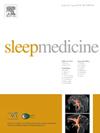Associations of reproductive factors and circadian syndrome in middle-aged and elderly women: A nationwide cross-sectional study from China, the United Kingdom and the United States
IF 3.8
2区 医学
Q1 CLINICAL NEUROLOGY
引用次数: 0
Abstract
Circadian Syndrome (CircS) was recently recognized as a novel predictor of cardiovascular disease (CVD) risk, with reproductive factors playing an important role in CVD risk. Yet, studies linking reproductive factors to CircS remain sparse. Data on middle-aged and elderly women were extracted from three nationally representative surveys: the China Health and Retirement Longitudinal Study (CHARLS) and the English Longitudinal Study on Ageing (ELSA) provided the training set, and the National Health and Nutrition Examination Survey (NHANES) constituted the validation set. We employed logistic regression to evaluate the association between self-reported reproductive factors and CircS risk, with inverse probability of treatment weighting (IPTW) and subgroup analyses conducted to verify the stability. A total of 11,721 participants were analyzed. CircS prevalence differed significantly across countries, with 51.40 % in China and 20.19 % in the United Kingdom. Early menarche (age <12 years) correlated with increased CircS risk in CHARLS (OR 1.38 [95 % CI 0.99–1.92]; p = 0.061), ELSA (OR 1.64 [95 % CI 1.36–1.98]; p < 0.001), and NHANES (OR1.52 [95 % CI: 1.21–1.89]; p < 0.001). Premature menopause (age <40 years) was associated with a roughly 30 % higher CircS risk. A shorter reproductive lifespan was significantly linked to CircS, with this relationship emerging at a reproductive lifespan of ≥40 years in CHARLS (OR1.39 [95 % CI: 1.04–1.84]; p = 0.024). The aforementioned correlations retained significance following IPTW and subgroup analyses. Early menarche, premature menopause, and abbreviated reproductive lifespans may negatively affect CircS. Public health strategies should incorporate menstrual cycle-related reproductive health into primary CircS prevention.

求助全文
约1分钟内获得全文
求助全文
来源期刊

Sleep medicine
医学-临床神经学
CiteScore
8.40
自引率
6.20%
发文量
1060
审稿时长
49 days
期刊介绍:
Sleep Medicine aims to be a journal no one involved in clinical sleep medicine can do without.
A journal primarily focussing on the human aspects of sleep, integrating the various disciplines that are involved in sleep medicine: neurology, clinical neurophysiology, internal medicine (particularly pulmonology and cardiology), psychology, psychiatry, sleep technology, pediatrics, neurosurgery, otorhinolaryngology, and dentistry.
The journal publishes the following types of articles: Reviews (also intended as a way to bridge the gap between basic sleep research and clinical relevance); Original Research Articles; Full-length articles; Brief communications; Controversies; Case reports; Letters to the Editor; Journal search and commentaries; Book reviews; Meeting announcements; Listing of relevant organisations plus web sites.
 求助内容:
求助内容: 应助结果提醒方式:
应助结果提醒方式:


